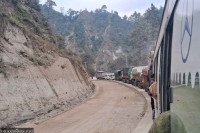Opinion
Upsetting the stag party
The first CA’s Women’s Caucus collectively pushed for women’s issues beyond party lines
Sabrina Singh
of women.
A step backward
However, the current CA does not have a Women’s Caucus. Although only an informal forum to push for gender equality, the formation of the Women’s Caucus in the first CA was symptomatic of a key hurdle women MPs have been experiencing: their own political parties. A caucus is an informal body of MPs across parties which aims to discuss issues and arrive at consensus. In the first CA, the Women’s Caucus was formed in January 2009 and consisted of 197 MPs from 19 political parties. The leadership of the Caucus changed on a rotational basis: each president completed a one-year term and could not be from the same party as the vice-president.
“The caucus was created due to our [women MPs’] courage,” said Mohamaddi Siddiqui, former coordinator of the Caucus and former parliamentarian from the Nepali Congress. “We submitted our charter and analysis to all 10 thematic committees of the CA, and even consulted with experts and researchers.”
Never mind how exemplary the rotational leadership structure and work ethic were. Never mind the collective women’s agenda that it published. The Caucus was still criticised to the point of oblivion on several grounds. “Some parties objected to the formation of a women’s caucus because they did not want women to bypass the party,” said Kamala Bishwakarma, current MP from the CPN (Marxist Leninist). “Others said that the caucus was controlled by foreign INGOs.” Party bosses feared that the success of the Women’s Caucus would challenge the hegemony of their own agendas. The Women’s Caucus alone, however, was not targeted.
Back to the parties
Indeed, there is a marked difference between the first CA and the current one. Today, none of the marginalised groups, including Dalits, Janajatis or Madhesis have been able to form caucuses. It appears that the success of the Janajati and Madhesi caucuses in standing together across party lines in the first CA particularly alarmed party bosses. In the absence of caucuses, it has become harder for MPs from marginalised groups to organise around common agendas.
“We [women] used to speak as one voice through the caucus or other platforms, but that practice has declined,” said Onsari Gharti Magar, vice-chairperson of the CA, at a public event. “Today, women have not been able to withstand pressure from their political parties. We used to not be worried about checking parties’ agenda before speaking out for women’s issues. Now, it is difficult to do so.”
Instead of uniting above party lines, the tide has taken a party-centric turn. Rather than a collective voice, today’s women MPs are instead campaigning individually and through their thematic committees. MP Kamala Bishwakarma noted, however, that despite the lack of a caucus, lawmakers were addressing issues of women and marginalised communities in other important ways. “The Capacity Enhancement and Resource Mobilisation Committee has been given the responsibility to represent the issues of marginalised groups and women,” she said. “We coordinate with our political parties and send drafts to the Political Dialogue and Consensus Committee.”
However, a party-centric approach to women’s political voice is hardly encouraging. Although caucuses are certainly not a panacea, it is doubtful whether political parties, if left to their own devices, can be true torchbearers for women’s representation. A recent analysis of political parties’ manifestos by a women’s organisation, Sankalpa, revealed that all eight party manifestos—including those of the Nepali Congress, CPN-UML, UCPN (Maoist) and the two Rastriya Prajatantra Parties—were silent on women’s inclusion within their own parties. Without any effort to have women in leadership positions within their party, it is doubtful whether parties are allowing women to penetrate key decision-making circles or that women’s representation will receive anything but lip service. Even more troubling is that although political parties have pledged certain candidacy percentages for women, many have not committed to their promises in the current CA.
All together now
A collective political voice holds more sway than fragmented or individual voices. It is a pity that a strong collective that had the potential to truly foreground women’s representation had such a short lifespan. “We need a women’s caucus in a country like Nepal because it can work beyond party lines,” said Mohna Ansari, member of the National Women’s Commission. “Many women still hold a patriarchal mindset. We need to have all women be clear on the women’s agenda and stand united. Without something like the caucus, we cannot bring all women in one basket.”
Today’s women lawmakers might not be resuscitating a women’s caucus, but it is the political parties that need to do their homework at a fundamental level. The question is, who will compel them to pay attention? It is encouraging that MPs from all four marginaised groups—Dalits, Madhesi, Janajati, and women—continue to organise themselves through other platforms. Perhaps, it is time for all four to band together and challenge all political parties to institutionalise inclusion.
Singh is an undergraduate student at Swarthmore College, the US. She is a fellow for Dayitwa: Nepal Public Service Fellowship




 13.98°C Kathmandu
13.98°C Kathmandu












